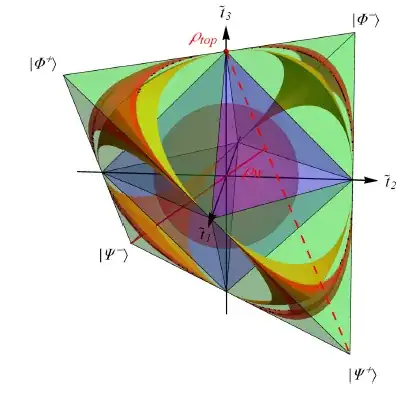The conditional von Neumann entropy is a concave function: if $\rho$ and $\sigma$ are states of a pair of registers $(\mathsf{X},\mathsf{Y})$ and $\lambda\in[0,1]$ is a real number, then
$$
\mathrm{H}(\mathsf{X}|\mathsf{Y})_{\lambda\rho + (1-\lambda)\sigma} \geq \lambda\, \mathrm{H}(\mathsf{X}|\mathsf{Y})_{\rho} + (1-\lambda)\,\mathrm{H}(\mathsf{X}|\mathsf{Y})_{\sigma}.
$$
It follows that the set of all states having nonnegative conditional von Neumann entropy is convex. This is true for $\mathsf{X}$ and $\mathsf{Y}$ being registers with arbitrary dimension.
Some things can be said about the set of all states having negative conditional von Neumann entropy. Every such state is entangled, for instance, but it is certainly not a convex set.
One way to prove that the conditional von Neumann entropy is concave is as follows. Consider the state
$$
\lambda\, \rho \otimes |0\rangle\langle 0| + (1-\lambda)\, \sigma \otimes |1\rangle\langle 1|
$$
of three registers $(\mathsf{X},\mathsf{Y},\mathsf{Z})$, where $\mathsf{Z}$ is a new, single qubit register that is being introduced for the sake of the proof. By the strong subadditivity of von Neumann entropy we have
$$
\mathrm{H}(\mathsf{X},\mathsf{Y},\mathsf{Z}) + \mathrm{H}(\mathsf{Y}) \leq \mathrm{H}(\mathsf{X},\mathsf{Y}) + \mathrm{H}(\mathsf{Y},\mathsf{Z}).
$$
If you evaluate each of the entropies in this inequality for the state above, and then rearrange using $\mathrm{H}(\mathsf{X}|\mathsf{Y}) = \mathrm{H}(\mathsf{X},\mathsf{Y})-\mathrm{H}(\mathsf{Y})$, you should get the concavity of conditional von Neumann entropy.
Of course, the strong subadditivity of von Neumann entropy is far from trivial to prove, but there are multiple known proofs, and if you search you will easily find one.

